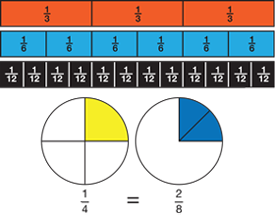This Workshop provides opportunities for students to address missing concepts, practice skills, or extend their learning as needed. Students compare fractions to benchmarks. They use tools such as fraction circle pieces and drawings to estimate fraction sums and differences. Then they practice adding and subtracting fractions with like and unlike denominators.
Content in this Lesson
- Comparing and ordering fractions using tools (e.g., area models, number lines), benchmarks, and multiplication and division strategies to find common denominators [E6].
- Adding and subtracting fractions including those with unlike denominators [E7].
- Using visual models or equations to represent the solution for word problems involving adding and subtracting fractions [E8].
- Using benchmark fractions to estimate sums and differences and assess the reasonableness of answers [E9].
- Choosing good tools and efficient strategies for solving problems [MPE2].
- Estimating to check for reasonableness [MPE3].
Daily Practice and Problems OO–RR
Assessment in this Lesson
| Assessment | Expectation Assessed | Math Practices Expectation Assessed |
|---|---|---|
|
Workshop: Problem Solving with Fractions |
|
|
|
Workshop: Problem Solving with Fractions |
|
|
|
Sharing Paper |
|
|















 and
and  since 15 is divisible by both 3 and 5.
since 15 is divisible by both 3 and 5.  and
and  .
. ,
, ,
, are equivalent to each other, and
are equivalent to each other, and  and
and  are equivalent to each other.
are equivalent to each other.